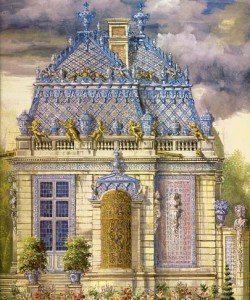By Christine A. Jones (W&M Contributor)
Not long after the construction of the legendary Taj Mahal, Louis XIV built a monument to passion, but it was not for his wife, Queen Maria Theresa. Over the course of his reign, he fell in love with other women who came to live at Versailles. His second paramour, the Marquise de Montespan, was a stunning social climber who caught his eye in 1666. Montespan’s penchant for excess was striking and earned her a dubious reputation at court. The king’s sister-in-law, the Duchesse d’Orléans, registered her distain in scathing descriptions. “[…] Montespan was a very capricious creature, who could never restrain herself in any way,” and “her ambition exceeded her debauchery.” Little wonder that Louis XIV adored her.
The king celebrated their passion in 1670 with an extravagant getaway built at one end of Versailles’ Grand Canal. Inspired by the Marquise’s taste for luxury, the King commissioned a richly exotic pavilion the likes of which Europe had never seen: its roof was covered in thousands of sparkling ceramic tiles and vessels done in the style of “blue and white” Ming china. Entering the “Trianon de porcelaine” was like walking into a porcelain universe. Inside, tiles covered the floors, painters finished white walls with cobalt blue motifs, and woodworkers contributed identically patterned furniture. Gardens were planted in such abundance that sometimes the scents were overwhelming. Architectural historian, André Félibien, recorded in 1673 that, “everyone found the palace enchanting.” It was a fairy-tale castle for a storybook romance.
But don’t look for it at Versailles today. During the 1680s, the aging king fell for the devoutly religious Madame de Maintenon, who turned him away from the wanton passions he had shared with the Marquise. Louis demolished the porcelain love shack in 1687 and built the Grand Trianon in marble to immortalize the glory of his reign, which, unlike his love, stood the test of time.
Christine A. Jones teaches French 17th/18th-century literature and culture at the University of Utah. She writes on fairy tales, porcelain, dance, and, most recently, wine.

